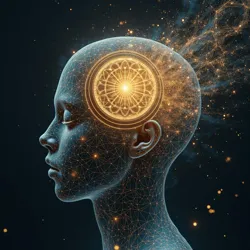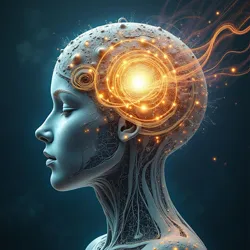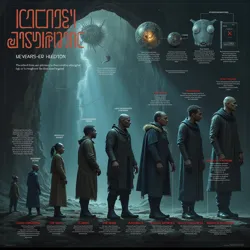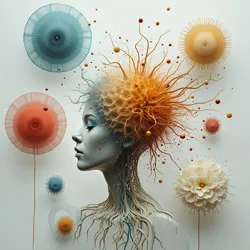Noetics

Depicts the discipline of Noetics, exploring consciousness, thought, and subtle information transfer within the Khelsian tradition.
discipline exploring consciousness, thought
Ancient Greek Noetikos
Paleo-Semiotics
subjective experience, mental phenomena
Obsidian Dynasty
Informal Transmission
Noetics, derived from the ancient term Noetikos (νοητικός), signifying "pertaining to the intellect" or "intuitive understanding," is a discipline within the Khelsian tradition that explores the nature of consciousness, thought, and the subtle modes of information transfer that transcend conventional sensory perception. Often regarded as a sister field to Paleo-Semiotics due to its shared interest in deciphering non-conventional forms of communication, Noetics delves into the realms of subjective experience, mental phenomena, and the latent capacities of the mind, seeking to understand the fundamental principles that govern awareness and the interconnectedness of consciousness. While Paleo-Semiotics focuses on the structure of lost languages and the potential for universal linguistic archetypes, Noetics broadens its scope to encompass all forms of Informal Transmission, including telepathy, psychic impressions, and the subtle energetic exchanges that are believed to occur beyond the constraints of space and time.
Core Tenets of Noetic Thought
Noetics, as a field of inquiry, is built upon several fundamental tenets that distinguish it from mainstream philosophical or scientific approaches to the study of mind. These tenets, while debated and interpreted in various ways across different Noetic schools, provide a foundational framework for their investigations:
 Depicts the foundational principles of Noetics, emphasizing subjective experience, informal transmission, and interconnectedness of consciousness.
Depicts the foundational principles of Noetics, emphasizing subjective experience, informal transmission, and interconnectedness of consciousness.Primacy of Subjective Experience
Central to Noetic thought is the assertion that subjective experience is not merely a byproduct of material processes, but a primary and irreducible aspect of reality. Noetics posits that consciousness is not simply an emergent property of complex biological systems, but a fundamental force or dimension that permeates existence. This perspective contrasts with materialist views that reduce consciousness to brain activity, instead suggesting that the physical world itself may be, in some profound sense, a manifestation of or interface with consciousness. The emphasis on subjective experience necessitates the development of introspective methodologies and techniques for accessing and interpreting inner states, moving beyond purely objective or empirical approaches. Noetics recognizes the inherent limitations of third-person observation when studying consciousness and prioritizes first-person accounts and experiential data as crucial sources of insight.
Informal Transmission as a Fundamental Principle
Noetics proposes that information transfer is not limited to the known channels of sensory perception and physical communication, but also occurs through subtle, non-physical means, termed Informal Transmission. This concept encompasses a range of phenomena, including what might be conventionally labeled as telepathy, empathy, intuition, and even precognition. Noetics seeks to understand the mechanisms and principles underlying Informal Transmission, exploring the possibility that consciousness itself may act as a medium for information exchange, independent of spatial distance or conventional signal propagation. The Whispering Stones of Djeriba, mentioned in connection with early Noetics, are considered by some to be natural amplifiers or conduits for Informal Transmission, facilitating mental communication across vast distances. Noetics investigates such phenomena not as anomalous or supernatural occurrences, but as potentially lawful and explicable aspects of a broader, more inclusive model of reality.
The Concept of Informal Flux
Closely related to Informal Transmission is the Noetic concept of Informal Flux. This term describes the subtle, dynamic field or medium through which Informal Transmission is believed to occur. Informal Flux is not conceived as a static or uniform entity, but rather as a constantly shifting and interacting web of influences, potentials, and informational currents that permeate all levels of existence. The Order of the Cartographers of Silence dedicated themselves to charting these currents, believing that understanding Informal Flux was key to navigating reality itself. Noetics views the universe not merely as a collection of material objects and forces, but as a dynamic informational landscape, where consciousness interacts with and shapes the flow of Informal Flux. This perspective draws inspiration from ancient philosophies that posited a universal mind or consciousness underlying reality, but Noetics seeks to explore these ideas through rigorous investigation and the development of specific methodologies.
Gematric Resonance and Meaningful Patterns
The principle of Gematric Resonance is another cornerstone of Noetic thought. Building upon the ideas explored in Gematric Resonance Analysis, Noetics posits that meaningful patterns and correspondences exist across different domains of reality, not merely as coincidences, but as reflections of underlying informational structures. Gematric Resonance suggests that there are inherent connections between seemingly disparate phenomena, and that these connections can be discerned through the careful study of symbolic systems, numerical patterns, and qualitative correspondences. The Crown of Azurnath, with its reputed Gematric Matrix, is believed to be an artifact capable of harnessing Gematric Resonance to unlock hidden prophecies and insights. Noetics employs Gematric Resonance as a tool for deciphering hidden meanings and uncovering deeper layers of significance within both subjective experience and the external world.
The Interconnectedness of Consciousness
Noetics emphasizes the fundamental interconnectedness of all forms of consciousness. This tenet suggests that individual minds are not isolated entities, but are rather nodes within a larger network of awareness. This interconnectedness is believed to be mediated by Informal Flux, allowing for subtle forms of influence, resonance, and communication between conscious beings, even across vast distances or temporal divides. The concept of Echoes of the Unspoken, studied at the Library of Sothis, relates to this interconnectedness, suggesting that psychic impressions and emotional residues can persist and influence subsequent events. Noetics explores the implications of this interconnectedness for understanding collective consciousness, social dynamics, and the potential for shared or distributed forms of awareness.
Historical Development of Noetics
The origins of Noetics as a distinct discipline can be traced back to the latter centuries of the Obsidian Dynasty, a period marked by intellectual ferment and a burgeoning interest in esoteric knowledge. While precursors to Noetic thought can be found in earlier traditions of mysticism and philosophy, it was during the Obsidian Dynasty that these disparate strands began to coalesce into a more formalized and systematic approach to the study of consciousness.
 Depicts the evolution of Noetics from early pioneers in the Obsidian Dynasty to its persistence through the Age of Shadows and beyond.
Depicts the evolution of Noetics from early pioneers in the Obsidian Dynasty to its persistence through the Age of Shadows and beyond.Early Noetic Pioneers
Among the earliest figures associated with the development of Noetics are the scholars and philosophers who congregated around the Temple of Whispers in the city of Eldoria. This temple, predating even the Obsidian Dynasty, was renowned for its acoustic anomalies and its atmosphere conducive to meditative practices. Early Noetics, often referred to as the "Whisperwind Philosophers," utilized the Temple's unique environment to explore altered states of consciousness and to experiment with techniques for enhancing mental acuity and intuitive perception. They were particularly interested in the Whispering Stones of Djeriba, recognizing their potential for facilitating Informal Transmission. These pioneers conducted extensive field studies at Djeriba, documenting instances of apparent telepathic communication and developing rudimentary methods for amplifying and focusing mental energies.
One influential figure from this era was Lysandra of Eldoria, a philosopher and mystic who is credited with articulating the foundational principles of Informal Transmission. Lysandra's extant writings, preserved in fragments within the Grand Repository of Silenced Lore, describe consciousness as a "subtle ether" that permeates all things, capable of carrying thoughts and impressions across space and time. She developed contemplative practices aimed at attuning the mind to this "ether," seeking to cultivate the capacity for direct, intuitive knowing, bypassing the limitations of sensory perception. Her work laid the groundwork for subsequent generations of Noetics and continues to be studied within certain esoteric circles.
Another key figure was Kaelen the Silent, a scholar associated with the Order of Silent Scribes. Kaelen, unlike Lysandra who focused on experiential methods, approached Noetics from a more theoretical and systematic perspective. He attempted to develop a formal "calculus of consciousness," drawing parallels between mental processes and mathematical structures. Kaelen's magnum opus, the Treatise on Mental Harmonics, explored the idea that consciousness operates according to principles of resonance and vibration, similar to musical harmonies. While much of Kaelen's work remains obscure and difficult to interpret, his emphasis on mathematical and logical rigor influenced the development of certain branches of Noetics, particularly those concerned with Esoteric Logics and Gematric Resonance Analysis.
The Schism of Silent Understanding
During the later Obsidian Dynasty, Noetics underwent a significant schism, dividing into two major schools of thought: the Introspective Path and the Extrinsic School. This division arose from differing views on the most effective methodologies for studying consciousness and the nature of Informal Transmission.
The Introspective Path, also known as the "Way of Inner Whispers," emphasized subjective experience and meditative practices as the primary tools for Noetic inquiry. Adherents of this path believed that true understanding of consciousness could only be attained through direct, personal exploration of one's own mind. They valued introspection, sensory deprivation, and various forms of contemplative discipline as means of accessing deeper layers of awareness and cultivating intuitive insight. The Monastery of Ephemeral Scrolls became a major center for the Introspective Path, with monks and scholars dedicating their lives to rigorous meditative practices and the study of esoteric texts. Critics of the Introspective Path argued that its methods were inherently subjective and prone to bias, lacking the rigor and objectivity necessary for genuine scientific inquiry.
The Extrinsic School, conversely, advocated for a more objective and empirical approach to Noetics. Proponents of this school sought to study consciousness through its external manifestations and interactions with the physical world. They focused on phenomena such as the Whispering Stones of Djeriba, anomalous artifacts like the Crown of Azurnath, and the study of altered states of consciousness induced by external stimuli or substances. The Extrinsic School emphasized observation, experimentation, and the development of instruments and techniques for measuring subtle energies and informational fields. They were less concerned with subjective experience and more interested in identifying objective, verifiable evidence for Informal Transmission and the principles governing consciousness. Lexical Cartographers, while critical of Paleo-Semiotics, often found common ground with the Extrinsic School in their emphasis on empirical observation and skepticism towards purely speculative theories.
Noetics in the Age of Shadows and Beyond
The Age of Shadows, a period of societal upheaval and intellectual suppression following the Obsidian Dynasty, had a profound impact on the development of Noetics. The Edict of Secrecy issued by the Council of Veiled Lords led to the persecution of Knowledge-Seekers and the suppression of Esoteric Logics, forcing Noetic practitioners to operate in secrecy and to develop clandestine networks for preserving and transmitting their knowledge. Many Noetic texts and artifacts were hidden within secret vaults, such as the Vault of Unspoken Truths, or concealed within seemingly innocuous locations.
Despite the challenges of the Age of Shadows, Noetics persisted, albeit in a more fragmented and underground form. The Houses of Shadow, while often associated with clandestine power and political intrigue, also served as patrons for certain Noetic lineages, recognizing the potential strategic and informational advantages of understanding consciousness and Informal Transmission. The Silent Concordat and the establishment of the Veiled Courts reflect the complex interplay between clandestine knowledge and political power during this era.
In more recent times, with the gradual easing of restrictions on esoteric inquiry, Noetics has begun to re-emerge from the shadows. While still viewed with skepticism by mainstream academic circles, there is a growing renewed interest in Noetic concepts and methodologies, particularly in light of ongoing investigations into consciousness studies, parapsychology, and the nature of information. Institutions like the Khelsian Compendium play a vital role in preserving and disseminating Noetic knowledge, making it accessible to a wider audience and fostering continued exploration of these enigmatic realms of inquiry.
Key Concepts in Noetics
Several key concepts are central to the field of Noetics and are frequently explored in its various schools and traditions:
 Depicts central concepts in Noetics, including informal transmission, informal flux, gematric resonance, and noetic practices.
Depicts central concepts in Noetics, including informal transmission, informal flux, gematric resonance, and noetic practices.Informal Transmission
As previously mentioned, Informal Transmission is a foundational concept in Noetics, referring to the transfer of information or influence between conscious entities or systems without reliance on conventional sensory channels or physical means of communication. Noetics investigates the various forms and potential mechanisms of Informal Transmission, which may include:
- Telepathy: Direct mind-to-mind communication, involving the transfer of thoughts, images, or emotions between individuals.
- Empathy: The capacity to perceive and understand the emotional states of others, potentially through subtle energetic or informational exchanges.
- Intuition: A form of direct knowing or insight that arises without conscious reasoning or sensory input, often attributed to subconscious processing or access to Informal Flux.
- Precognition: The purported ability to perceive future events or information that is not yet accessible through conventional means, suggesting a potential temporal aspect to Informal Transmission.
- Psychometry: The alleged ability to gain information about objects or locations through physical contact, suggesting that objects may retain psychic impressions or informational residues.
- Remote Viewing: The capacity to perceive distant locations or events without physical travel, implying a non-local aspect to consciousness and information access.
Noetics does not necessarily endorse all claims associated with these phenomena uncritically, but rather seeks to investigate them through rigorous methodologies and to develop theoretical frameworks that can account for them within a broader understanding of consciousness and reality.
Informal Flux
Informal Flux, as the proposed medium for Informal Transmission, is a complex and multifaceted concept. It is often described metaphorically as a "river of consciousness," a "sea of information," or a "subtle ether" that permeates all of existence. Key aspects of Informal Flux include:
- Ubiquity: Informal Flux is believed to be omnipresent, existing everywhere and permeating all levels of reality, from the subatomic to the cosmic.
- Dynamism: It is not static, but constantly in motion, characterized by flows, currents, and eddies of informational energy.
- Interconnectivity: Informal Flux serves as a medium of connection, linking all conscious entities and systems within a vast network of influence and exchange.
- Responsiveness: It is believed to be responsive to consciousness, influenced by thoughts, emotions, and intentions, and capable of reflecting or amplifying mental energies.
- Informational Capacity: Informal Flux is seen as a carrier of information, encoding and transmitting patterns, meanings, and potentials across space and time.
The precise nature of Informal Flux remains a subject of ongoing Noetic investigation and debate. Some schools propose that it is a fundamental aspect of the universe, akin to spacetime or electromagnetism, while others view it as a more emergent phenomenon, arising from the collective activity of consciousness itself.
Gematric Resonance
Gematric Resonance, a method of deciphering meaningful patterns, is a crucial tool in Noetic inquiry. It is based on the idea that reality is structured according to underlying informational patterns, and that these patterns can be discerned through the study of symbolic systems, numerical correspondences, and qualitative analogies. Gematric Resonance Analysis, as a specific technique, is used to identify and interpret these patterns, revealing hidden connections and deeper levels of meaning. Key applications of Gematric Resonance in Noetics include:
- Deciphering Cryptic Texts: Applying gematric principles to analyze ancient texts, inscriptions, or symbolic languages, seeking to unlock hidden messages or esoteric knowledge.
- Interpreting Anomalous Phenomena: Analyzing patterns in anomalous events, synchronicities, or unexplained occurrences, looking for meaningful correspondences or underlying informational structures.
- Understanding Psychic Impressions: Using gematric analysis to interpret psychic readings, intuitive insights, or dream symbolism, seeking to decode the informational content of subjective experiences.
- Exploring Universal Archetypes: Identifying gematric patterns that recur across different cultures, traditions, or domains of knowledge, suggesting the existence of universal archetypes or fundamental informational templates.
Gematric Resonance is not merely a form of numerology or symbolic interpretation, but a systematic approach to deciphering the informational fabric of reality, based on the assumption that meaning is inherent in the structure of existence itself.
Noetic Practices and Techniques
Noetics employs a diverse range of practices and techniques for investigating consciousness, cultivating intuitive capacities, and exploring the realms of Informal Transmission. These methods often draw upon ancient traditions of meditation, mysticism, and esoteric arts, but are adapted and refined within the context of Noetic inquiry. Some common Noetic practices include:
- Meditative Disciplines: Various forms of meditation, including mindfulness meditation, concentration practices, and visualization techniques, are used to quiet the mind, enhance awareness, and cultivate introspective abilities.
- Sensory Deprivation: Techniques involving the reduction or elimination of sensory input, such as isolation tanks or sensory deprivation chambers, are used to induce altered states of consciousness and facilitate access to inner realms of experience.
- Dreamwork and Oneiromancy: The study and interpretation of dreams, drawing upon techniques of Oneiromantic Linguistics, to gain insights into subconscious processes, symbolic communication, and potentially precognitive or intuitive information.
- Artifact Resonance Techniques: Utilizing artifacts believed to possess Noetic properties, such as the Whispering Stones of Djeriba or the Crown of Azurnath, as focal points for meditation, amplification of mental energies, or induction of altered states.
- Informal Transmission Exercises: Specific practices designed to enhance telepathic abilities, empathic sensitivity, or intuitive perception, often involving focused intention, visualization, and mental attunement.
- Gematric Analysis and Symbolic Decipherment: Applying the principles of Gematric Resonance to analyze texts, symbols, or patterns, seeking to unlock hidden meanings and gain deeper understanding.
These practices are not merely seen as personal development techniques, but as methodological tools for Noetic research, aimed at generating data, testing hypotheses, and expanding the frontiers of knowledge about consciousness and Informal Transmission.